Manufacturing stumbles have cost it business. AMD, its most direct rival, outsources production to Taiwan Semiconductor Manufacturing Company (TSMC), whose technology is now ahead of Intel's. That means AMD's chips are generally faster, and consume less power; its market share has more than doubled since 2019.
芯片制造上的挫敗使英特爾傷到元氣。其最直接的競爭對手AMD將生產外包給臺積電(TSMC),而后者的技術目前領先于英特爾。這意味著AMD公司的芯片速度普遍更快,功耗更低;自2019年以來,AMD的市場份額翻了一番多。
A second challenge is the industry’s growing specialisation—a problem for Intel’s traditional forte of general-purpose chips, especially if desktop pcs continue to stagnate. Technology giants, flush with cash and keen to extract every drop of performance for their specific purposes, increasingly design their own semiconductors. In 2020 Apple said it would drop Intel from its laptops and desktops in favour of custom-designed chips. Amazon is rolling out its “Graviton” cloud-computing processors, also designed in-house and made by TSMC. Microsoft, whose cloud business is second only to Amazon’s, is rumoured to be working on something similar.
英特爾面臨的第二個挑戰是芯片制造行業逐漸走向定制化,這是英特爾通用芯片(英特爾的傳統王牌產品)所面臨的問題,尤其是在臺式電腦繼續停滯不前的情況下。科技巨頭們資金充裕,熱衷于為自己的特定需求而榨取全部性能,進而不斷更新自家的半導體設計。2020年,蘋果表示將放棄在其筆記本電腦和臺式機上使用英特爾芯片,轉而采用定制設計的芯片。亞馬遜正在推出其“Graviton”云計算處理器,該處理器也經由臺積電(TSMC)自主設計和制造。云計算業務僅次于亞馬遜的微軟據傳也在進行類似的工作。

Intel has also failed to make any headway in smartphones, the most popular computers ever made. An effort in the late 1990s to build graphics chips, which have also proved handy for artificial intelligence (AI), and to which Nvidia owes its enviable valuation, petered out. Attempts to diversify into clever new sorts of programmable or memory chips—in 2015 it paid $16.7bn for Altera, which makes them—have so far not paid off in a big way.
英特爾在智能手機這一有史以來最受歡迎的計算機領域也未能取得任何進展。上世紀90年代末,英特爾公司致力于研發圖形芯片,事實證明,圖像芯片也有益于人工智能(AI)。英特爾逐漸放棄了研發工作,而英偉達在圖形芯片上的努力使其獲得了令人羨慕的估值。英特爾試圖實現產品多樣化,開發新型可編程芯片或內存芯片,2015年,英特爾斥資167億美元收購制造上述芯片的阿爾特拉公司(Altera),但迄今尚未獲得大的回報。
Mr Gelsinger has yet to say how he plans to deal with the challenges. He does not look like a revolutionary. He began working at Intel aged 18, before leaving in 2009 to preside over EMC, a data-storage firm, and for the past nine years heading VMware, a software firm. In an email to Intel’s staff after his appointment was announced he invoked its glory days, recalling being “mentored at the feet of Grove, Robert Noyce and Gordon Moore”, the last two being the firm’s founders. Like them but unlike his predecessor, Bob Swan, Mr Gelsinger is an engineer, who in 1989 led the design of a flagship chip.
基爾辛格還沒有說明他計劃如何應對這些挑戰。他看起來不像一位革命者。他18歲時開始在英特爾工作,2009年離職后執掌數據存儲公司易安信(EMC),過去九年來一直領導軟件公司威睿(VMware)。宣布就任后,在給英特爾員工的一封電子郵件中,他提到了英特爾的輝煌歲月,回憶起自己“曾接受過格羅夫、羅伯特·諾伊斯和戈登·摩爾的指導”(后兩位是英特爾的創始人)。基爾辛格與他們一樣是工程師(這點與前任總裁鮑勃·斯旺不同),他在1989年領導了一款旗艦芯片的設計。
譯文由可可原創,僅供學習交流使用,未經許可請勿轉載。











